- Joined
- Nov 19, 2013
- Messages
- 1,515
- Reaction score
- 613
Over the last 7 years it's been my pleasure to be invited to an annual French & Indian War re-enacting event that takes place on Lake George. We begin the Sunday of Columbus Day Weekend and go through until the following Thursday. While the public tends to see us as we move about, the event is really for
re-enactors and it's where we try to emulate, as much as possible in the 21st century, what life may have been like for the soldiers and their Native allies during the late 1750s. Since Lake George was the site of a lot of action during this war, it's fitting that this event be held here.
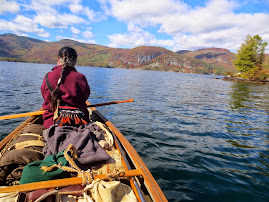
As we paddled in on Sunday the lake was particularly calm and inviting. We said a prayer, offered some tobacco and paddled south to meet up with our Abenaki allies. In the past few years we've base camped on Floating Battery; one of the many islands in the lake. The island is home to the remains of French fortifications from the mid 18th century; as are many of the smaller islands in that area. It's pretty incredible to see hand cut stonework as you paddle past the islands, knowing that these once protected armies in this conflict. We were also blessed this year to have a Bald Eagle flying with us as we headed down the lake (sorry no photos).
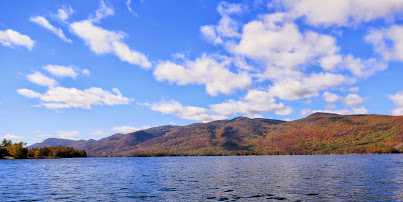

This small chapel is dedicated to Father Isaac Jogues; a 17th century Jesuit priest. Jogues was sent amongst the Iroquois to convert them to Catholicism. Although somewhat successful, he eventually was martyred by the Mohawks near present day Fonda, NY in the Mohawk Valley. Prior to his death he survived a great deal of torture, loosing a finger and suffering a great deal of pain. Thankfully as a "Frenchman," I am allied to the Abenaki and not the cannibalistic heathens of the longhouse.
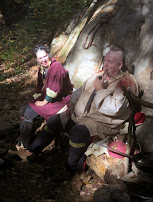
Arriving at camp we meet with the chief and spend time renewing our friendship. This fire area is a the center point of the site and is wonderfully protected from the winds that blow in off the lake. It's also down in a hollow which makes it a great place to hide from the enemy.

The main encampment is on the lower end down by the fire pit area. I prefer to be up higher for a variety of reasons including a nice breeze and being able to see who or what is coming my way. My "home" is a 10'x10 oilcloth that has kept me safe, dry and warm in some incredible rain & wind storms. While it doesn't look like much it has everything I need. For this event I bring two wool blankets and sleep on top of my bearskin (an 18th century version of a Therma-Rest pad). To my side I keep my musket, shot bag, food bag and clothing (my gear is closest to the camera in this shot).

By having all this gear with me I can be assured of having everything I need when I need it. I also take a small brazier (think charcoal grill) that is period appropriate. With the brazier I can make small contained cooking fires under the oilcloth if the weather dictates. Bottom line, it's all "ancient" technology but it all works.
The weather on this trip wasn't the greatest. In fact, it was pretty typical of the lake at this time of year; unsettled. Because of that we didn't venture off the island too much but we still need to be on guard for the "enemy" who might try and sneak up on us. For that reason I would periodically go out on patrol and work the perimeter of the island. Floating Battery is considered haunted by many. There are a legion of ghost stories and the most famous one is of the ghost of the French Marine. Whether you believe in ghosts or not, I know I saw him one night a few years ago while out on a night patrol. This year we heard voices in the middle of the day. Since at least 5 other people heard them too, we went out to survey whether we were alone or not. While finding no one, I would never say you're alone on this island.
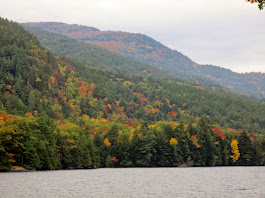
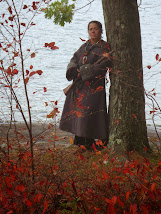
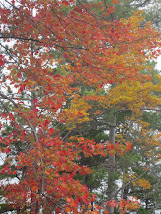

(me on patrol looking to the western shore)
If nothing more, this week is a great time to cook period foods and enjoy everyone's company. We try to keep to food that would have, or could have, been available during that time period. Typical drinks are hot chocolate and brandy while food can range from parched corn, jerky and more elaborate meals.


As the week's weather was unpredictable, and we weren't seeing too many other people out on the lake, we decided to get out the first break in the weather that looked good. The day before I went out there were a few others who left earlier. One of the guys has a sail set up which, I've been told, can be documented to Native use; although not common. Luckily for them, they got out while the getting was good.
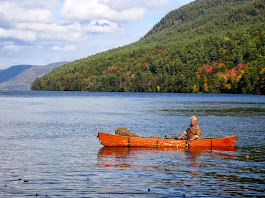


As for our little group, by the time we left the next day the weather was a lot more sour. We left Floating Battery around 7:30 AM, hoping to get going before the winds built up. Unfortunately for us, about 10 minutes after leaving the island we needed to take refuge on St. Sacrament island just to the north. We were wind bound for about 2 hours before the white caps died down enough that we were willing to get back on the water. Once we were around the island and heading north again the wind had a larger area to spread out across so it was a lot more manageable. From there we played off various points and islands until we made it safely back to the beach were our adventure had started. Since the weather was dicey, I don't have any photos from the trip back but I'll leave you with one of the elders in our group. As you can see, I'm the token white guy. All of these folks are Native and, with the exception of one person, all members of the El Nu Abenaki tribe which is recognized by the state of VT. This is their annual tribute to their ancestors and I feel privileged to be invited amongst them each year.
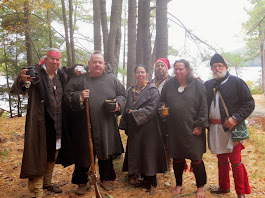
That's all for now. Take care and until next time...Be well.
snapper
re-enactors and it's where we try to emulate, as much as possible in the 21st century, what life may have been like for the soldiers and their Native allies during the late 1750s. Since Lake George was the site of a lot of action during this war, it's fitting that this event be held here.
As we paddled in on Sunday the lake was particularly calm and inviting. We said a prayer, offered some tobacco and paddled south to meet up with our Abenaki allies. In the past few years we've base camped on Floating Battery; one of the many islands in the lake. The island is home to the remains of French fortifications from the mid 18th century; as are many of the smaller islands in that area. It's pretty incredible to see hand cut stonework as you paddle past the islands, knowing that these once protected armies in this conflict. We were also blessed this year to have a Bald Eagle flying with us as we headed down the lake (sorry no photos).
This small chapel is dedicated to Father Isaac Jogues; a 17th century Jesuit priest. Jogues was sent amongst the Iroquois to convert them to Catholicism. Although somewhat successful, he eventually was martyred by the Mohawks near present day Fonda, NY in the Mohawk Valley. Prior to his death he survived a great deal of torture, loosing a finger and suffering a great deal of pain. Thankfully as a "Frenchman," I am allied to the Abenaki and not the cannibalistic heathens of the longhouse.
Arriving at camp we meet with the chief and spend time renewing our friendship. This fire area is a the center point of the site and is wonderfully protected from the winds that blow in off the lake. It's also down in a hollow which makes it a great place to hide from the enemy.
The main encampment is on the lower end down by the fire pit area. I prefer to be up higher for a variety of reasons including a nice breeze and being able to see who or what is coming my way. My "home" is a 10'x10 oilcloth that has kept me safe, dry and warm in some incredible rain & wind storms. While it doesn't look like much it has everything I need. For this event I bring two wool blankets and sleep on top of my bearskin (an 18th century version of a Therma-Rest pad). To my side I keep my musket, shot bag, food bag and clothing (my gear is closest to the camera in this shot).
By having all this gear with me I can be assured of having everything I need when I need it. I also take a small brazier (think charcoal grill) that is period appropriate. With the brazier I can make small contained cooking fires under the oilcloth if the weather dictates. Bottom line, it's all "ancient" technology but it all works.
The weather on this trip wasn't the greatest. In fact, it was pretty typical of the lake at this time of year; unsettled. Because of that we didn't venture off the island too much but we still need to be on guard for the "enemy" who might try and sneak up on us. For that reason I would periodically go out on patrol and work the perimeter of the island. Floating Battery is considered haunted by many. There are a legion of ghost stories and the most famous one is of the ghost of the French Marine. Whether you believe in ghosts or not, I know I saw him one night a few years ago while out on a night patrol. This year we heard voices in the middle of the day. Since at least 5 other people heard them too, we went out to survey whether we were alone or not. While finding no one, I would never say you're alone on this island.
(me on patrol looking to the western shore)
If nothing more, this week is a great time to cook period foods and enjoy everyone's company. We try to keep to food that would have, or could have, been available during that time period. Typical drinks are hot chocolate and brandy while food can range from parched corn, jerky and more elaborate meals.
As the week's weather was unpredictable, and we weren't seeing too many other people out on the lake, we decided to get out the first break in the weather that looked good. The day before I went out there were a few others who left earlier. One of the guys has a sail set up which, I've been told, can be documented to Native use; although not common. Luckily for them, they got out while the getting was good.
As for our little group, by the time we left the next day the weather was a lot more sour. We left Floating Battery around 7:30 AM, hoping to get going before the winds built up. Unfortunately for us, about 10 minutes after leaving the island we needed to take refuge on St. Sacrament island just to the north. We were wind bound for about 2 hours before the white caps died down enough that we were willing to get back on the water. Once we were around the island and heading north again the wind had a larger area to spread out across so it was a lot more manageable. From there we played off various points and islands until we made it safely back to the beach were our adventure had started. Since the weather was dicey, I don't have any photos from the trip back but I'll leave you with one of the elders in our group. As you can see, I'm the token white guy. All of these folks are Native and, with the exception of one person, all members of the El Nu Abenaki tribe which is recognized by the state of VT. This is their annual tribute to their ancestors and I feel privileged to be invited amongst them each year.
That's all for now. Take care and until next time...Be well.
snapper
